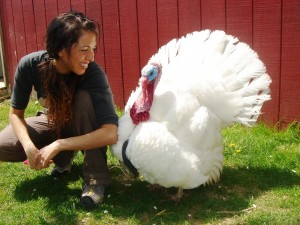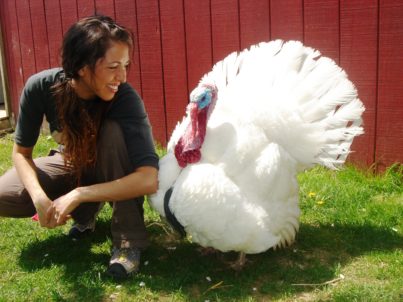If you’ve ever sympathized with the plight of animals used for dog fighting, abused in circuses and laboratory research or killed for trophy hunting, fur and factory farming, you can make a difference by acting on your convictions and allying yourself with an organization that reflects your viewpoints. If you believe that animals deserve the basic rights to enjoy a life of humane conditions that are free of abuse, oppression and confinement, then you can advocate in the following ways.

Step One: Educate yourself and get a firm grasp on your position.
Animal rights advocates are a diverse bunch, holding a wide range of view points. The first step to taking action is figuring out where you stand.
Some activists focus on animal welfare, deeming it important for animals to be treated, and even killed, humanely. Others believe human beings are not entitled to use animals for food, medical experimentation, sport and clothing. There are different degrees of advocacy that correspond to these various beliefs, from advocacy pertaining to anti-abuse legislation to more aggressive animal liberation stances.
Once you’ve got a grasp on what you believe – read up on the issues most important to you.
Here are some starters:
Factory farming
Seal hunting
Puppy mills
Dog fighting
Step Two: Understand that not everyone thinks the same way you do.
Maintaining an open minded perspective can be very beneficial when you’re attempting to promote animal rights to the masses. Rather than running the risk of appearing extreme in your beliefs, if you can respect more mainstream or opposing positions, you will be more likely to be able to spread your message with a greater level of success. Some people will believe in ethical hunting, whereas others will completely disagree. Some extreme animal rights activists have experienced backlash because of their over-the-top antics used to capture public attention. If you really want to make a genuine connection with people on the street, sometimes it is far more effective to find out what makes them tick and approach your animal rights promotion from a place of respectful education and illumination.
Step Three: Ally yourself with a pre-existing group or start one of your own.
Strength in numbers is applicable for many causes and certainly so when you’re campaigning to spread the word about animal rights. Your message is more likely to be heard when you have the backing of similarly minded individuals who are all working toward a common goal. You can also cover a lot more ground when you benefit from pre-existing strategies, proper organization and large budgetary resources. Animal-focused organizations range from the controversial People For The Ethical Treatment of Animals (PETA) to the not-so-controversial Humane Society, each with distinctly different methods of reaching the public. Do your homework, first by researching their mission statements online and exploring the way they deliver their belief system and then by locating a satellite office in your neck of the woods. If you find after all is said and done that your views aren’t compatible, consider taking matters into your own hands by creating your own group via Meetup.com or another social network avenue. Networking with local vegetarian societies, animal rescue facilities, health food stores, college campuses and even attending animal themed conferences will help you to locate potential members who will want to rally around the same cause that you have an affinity for.
Step Four: Spread the word by setting up a website or blog.
If you are working with a pre-existing organization, use the online social networking tools they already possesss to spread your message. Inquire if they’re looking for passionate bloggers to lend additional voices to their site.
If you’re branching out on your own, becoming a valuable source of animal rights information could potentially mushroom into a second career. Ultimately, establishing yourself as an authority, via your own website or blog, will slowly but surely gain you a following and in our world of online-driven education, that’s all you really need to change lives in an impactful way.
Once you become a fixture in any online venue, people will want to hear what you have to say and be more likely to ban together with you on future animal rights projects that you work on.
Step Five: Hit the pavement.
Considered to be an old-fashioned way of reaching the public in comparison to today’s mouse-clicking, instant gratification standards, physically handing out flyers emblazoned with animal rights facts to strangers on the street can still be an effective tactic.
Some things to keep in mind:
- Animal rights advocates tend to be proponents of living a greener lifestyle, so handing out reams of garbage-can-bound paper is not exactly eco-acceptable.
- Also, if you’re going to walk this path, be sure to wear your toughest street armor since there are always a few in the crowd who aren’t afraid to share offensive remarks with you. Let negative comments roll right off and remind yourself that it’s all in a day’s work, especially if you are ultimately able to help others achieve a light bulb moment.
Step Six: Organize an animal rights awareness event.
While this may be a lot of effort, a well-executed soiree that not only engages the public and spreads knowledge, but could also potentially raise funds for local animal related causes. Create a thoroughly outlined proposal and pitch it to local high schools, colleges, libraries and community centers. Organizations of this nature continually seek recreational and educational programs to augment their offerings. Whether you get the thumbs-up to deliver one or 20 events, your resulting networking opportunities in the community will be well worth all of the sweat equity you invested up front. Any project that enlightens and educates on behalf of those who aren’t able to speak up for themselves makes the world a better place – and each person you are able to get on board means that more animal lives will reap the benefits.
Eliza Leigh is contributing writer to Causecast.org:Causecast: Transforming Interest Into Action. Originally posted here.



